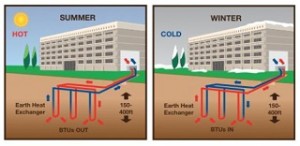Investment Opportunity: Project Financing for Large Geothermal Heat Pump Projects

Of course, developers, architects, and owners of large industrial and commercial real estate (as well as multi-family residences) can earn LEED points for everything from bicycle racks to waterless urinals, and there is nothing wrong with that. But when it comes to straightforward reduction in greenhouse gas emissions from fossil fuel consumption, it’s tough to beat geothermal, with its capacity to reduce energy bills (and the fuel required to generate that energy) by up to 80%.
Here’s an investment opportunity I’d like to recommend. Called “Diverso Energy,” it has a few unique features that are extremely attractive. In particular, each project completed:
• Greatly decreases the capital expense related to heating and air conditioning by eliminating the need for cooling towers and boilers; converts the up-front cost of installing these systems into operating expenses that are paid over long periods of time (the geothermal system will likely outlast the building itself).
• Reduces operating expenses vs. traditional heating and cooling systems, insofar as geothermal runs on very little power ; it also removes the risk of escalating energy prices over the coming decades (something that is very likely almost certain to occur).
• Invokes the same business model as Solar City (market cap $3.3 billion), but with major benefits over solar PV. Here, the cash flow from the projects is far more secure than PV on a roof that can break or degrade, or be bypassed if the customer simply goes back to the grid. If these Diverso contracts are broken, the heat and cooling to the building can be turned off completely and immediately.
• Provides those who are concerned about the environment (or may be feeling the pinch of government regulatory bodies) to rest assured that this solution is incredibly “green.” Most owners and tenants of such buildings put a value on the PR aspect of being eco-conscious, and this value will only increase over time as our civilization comes to a more complete appreciation of the environmental calamity in which it finds itself.
Again, we’re talking about debt / project finance here, with an attractive rate of return and extremely low risk.
I would ask anyone interested to contact me, and I’ll put you in direct touch with the principals.

sir, pl send me more details and confirm whether it can be implemented at India and finance can be provided to Indian Developer. What is project cost?
Please see my email to you.
We have Projects in belgium
Please see my email to you. Thanks.
This technology has always been available so it’s somewhat surprising that it has not previously been widely used. It may well save more energy than putting PV collectors on roofs.
I’m again reminded of Teddy’s advice, “Do what you can, with what you have, where you are.”
This system should be particularly attractive for areas with district heating and or district cooling – where the heat pumps can be connected to large thermal stores both hot and cold and used to add flexibility to the power grid supporting the integration of more wind and solar power.
Stored hot or cold water can deliver sanitary hot water, heating, and cooling on demand without requiring the addition of firm generating capacity. (A large thermal store has far lower cost per kWh thermal than a small one, and performs better due to the relationship between volume and surface area – damping out variations in wind and solar output over several days)
In hot coastal climates, district cooling using sea water drawn from well below the surface should be a particularly attractive and may offer sufficient cooling through a heat exchanger even without the addition of a heat pump. Hawaii and California may offer attractive opportunities for this type of district cooling as would any area with cool marine currents or near shore deep water.
(The financial district of Stockholm has both district heating and district cooling)